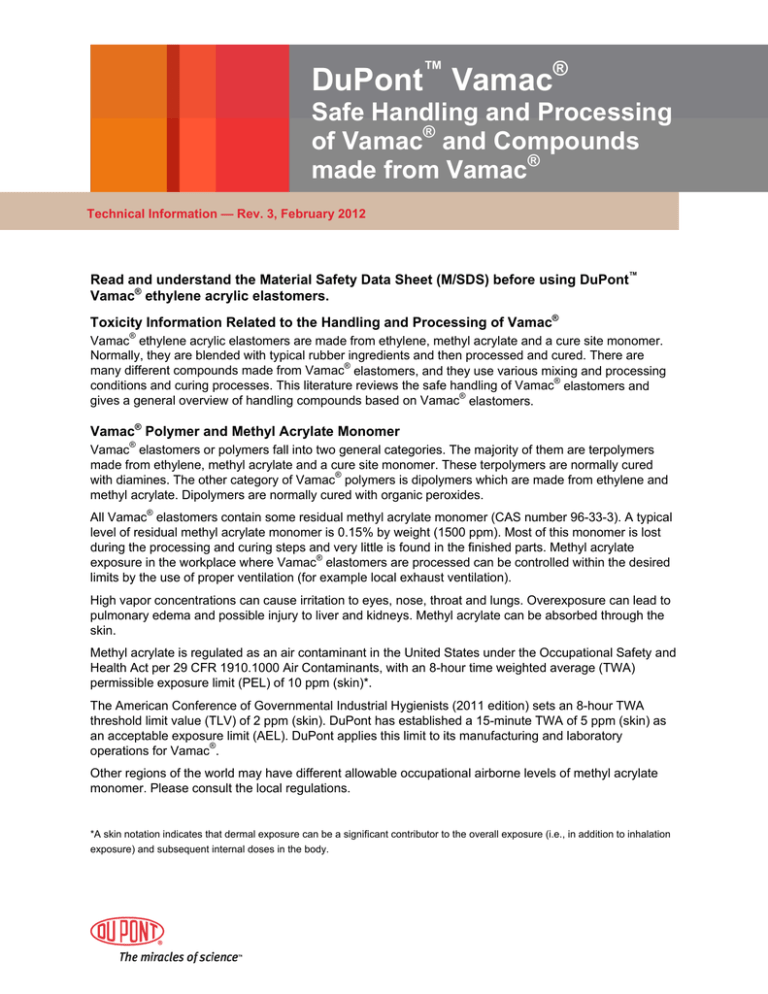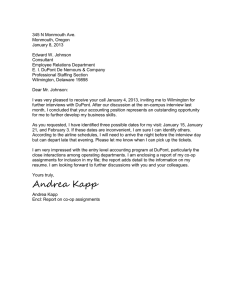
DuPont™ Vamac®
Safe Handling and Processing
of Vamac® and Compounds
made from Vamac®
Technical Information — Rev. 3, February 2012
Read and understand the Material Safety Data Sheet (M/SDS) before using DuPont™
Vamac® ethylene acrylic elastomers.
Toxicity Information Related to the Handling and Processing of Vamac®
Vamac® ethylene acrylic elastomers are made from ethylene, methyl acrylate and a cure site monomer.
Normally, they are blended with typical rubber ingredients and then processed and cured. There are
many different compounds made from Vamac® elastomers, and they use various mixing and processing
conditions and curing processes. This literature reviews the safe handling of Vamac® elastomers and
gives a general overview of handling compounds based on Vamac® elastomers.
Vamac® Polymer and Methyl Acrylate Monomer
Vamac® elastomers or polymers fall into two general categories. The majority of them are terpolymers
made from ethylene, methyl acrylate and a cure site monomer. These terpolymers are normally cured
with diamines. The other category of Vamac® polymers is dipolymers which are made from ethylene and
methyl acrylate. Dipolymers are normally cured with organic peroxides.
All Vamac® elastomers contain some residual methyl acrylate monomer (CAS number 96-33-3). A typical
level of residual methyl acrylate monomer is 0.15% by weight (1500 ppm). Most of this monomer is lost
during the processing and curing steps and very little is found in the finished parts. Methyl acrylate
exposure in the workplace where Vamac® elastomers are processed can be controlled within the desired
limits by the use of proper ventilation (for example local exhaust ventilation).
High vapor concentrations can cause irritation to eyes, nose, throat and lungs. Overexposure can lead to
pulmonary edema and possible injury to liver and kidneys. Methyl acrylate can be absorbed through the
skin.
Methyl acrylate is regulated as an air contaminant in the United States under the Occupational Safety and
Health Act per 29 CFR 1910.1000 Air Contaminants, with an 8-hour time weighted average (TWA)
permissible exposure limit (PEL) of 10 ppm (skin)*.
The American Conference of Governmental Industrial Hygienists (2011 edition) sets an 8-hour TWA
threshold limit value (TLV) of 2 ppm (skin). DuPont has established a 15-minute TWA of 5 ppm (skin) as
an acceptable exposure limit (AEL). DuPont applies this limit to its manufacturing and laboratory
operations for Vamac®.
Other regions of the world may have different allowable occupational airborne levels of methyl acrylate
monomer. Please consult the local regulations.
*A skin notation indicates that dermal exposure can be a significant contributor to the overall exposure (i.e., in addition to inhalation
exposure) and subsequent internal doses in the body.
The odor threshold for methyl acrylate is approximately 14 parts per billion (ppb). Therefore, sense of
smell is not a reliable indicator of the methyl acrylate airborne concentration in an area. Repeated
exposure can desensitize the nose.
Adequate control of exposure to methyl acrylate and other decomposition products from processing can
be realized by proper ventilation. The ventilation requirements of each plant location and operation may
differ sufficiently to warrant individual methyl acrylate monitoring of each area. Areas where DuPont™
Vamac® is stored should be assessed as well as the processing areas. Actual concentration of methyl
acrylate in air can be determined by using a gas analyzer.
The DuPont brochure on “Proper Use of Ventilation During Processing of Plastics” has some good
suggestions on how to limit worker exposure to air borne chemicals. Please contact your local DuPont
representative if you would like a copy.
Compounds made from Vamac® – Handling Precautions while Processing
There are many possible steps used to process compounds made from Vamac® including mixing,
molding, de-molding, extrusion, curing, post curing, etc. During the processing steps, some gaseous
byproducts will be vaporized into the air in the immediate work area. The composition of these vapors will
depend on the compounding ingredients added to the compound along with the process conditions such
as temperature and pressure. Many of the rubber compounding ingredients have a substantial vapor
pressure at elevated temperatures and can contribute significantly to the amount of volatiles. Therefore,
only general guidelines for handling precautions can be provided.
As mentioned previously, most of the Vamac® polymers used today are based on terpolymers (i.e.
Vamac® G and Vamac® GLS) and these are cured with diamines. The following discussion relates to
terpolymers. Dipolymers are cured with peroxides and will have different volatiles.
A typical compound made from a Vamac® terpolymer may have a formulation that has the ranges listed
below:
• 100 parts polymer
• 50 to 80 parts carbon black
• 0 to 20 parts of a plasticizer
• 1 to 3 parts of a release package
• 1 to 3 parts of an anti-oxidant
• 1 to 2 parts of a curative – usually hexamethylene diamine carbamate (HMDC)
• 1 to 5 parts of an accelerator – diorthotolyl guanidine (DOTG) or Diazobicyclo undecene (DBU)
The compound will usually be mixed on an internal mixer at about 100 °C (212 °F) and then sheeted off
on a roll mill. It will then either be extruded into a hose or molded. Typical process temperatures for
extruding hoses are about 60 to 90°C (140 to 194°F). For molding, the temperature can be around 180°C
(356°F). For most of the molding cycle the mold is closed and under pressure (limited volatiles) but at the
end of the molding cycle the mold is open to atmospheric pressure and this is when the volatiles
concentration will be the highest.
In the final processing step a hose will be cured in an autoclave at about 175 °C (347 °F) under pressure.
Molded parts are usually post cured for several hours at about 175 °C (347 °F) at ambient pressure.
During the curing step the HMDC curative will break down to hexamethylene diamine (HMDA) and carbon
dioxide (CO2). Also during the cure step the diamine/cure site reaction will generate water and ethanol.
The weight loss from these volatiles for a compound with 1.5 phr of HMDC and a total of 200 parts will be:
• 0.21% weight loss from CO2 produced when HMDC is converted to HMDA
• 0.17% weight loss from water generated during cure
• 0.43% weight loss from ethanol generated during cure
The total volatiles from the cure system (CO2, water and ethanol) are about 0.8% by weight for a typical
compound.
The amount and nature of the other volatiles encountered during the vulcanization of an elastomer are
difficult to assess since chemical side reactions can take place. These reactions and the volatiles
2
generated depend on the specific compound formulations and the type of curing system. The
concentration of volatiles in a given area will depend on many factors including the length of the heating
cycle, the size of the part, the access to the atmosphere, the size of the area and the degree of air
circulation.
The off-gases generated in the curing of a typical compound made from a Vamac® terpolymer are shown
in Table 1. These values are shown for information only and should not be used to predict concentrations
of off-gases in a given work area. If there are any questions, it is suggested that processors of
compounds made from Vamac® monitor for possible off-gases and measure the actual concentrations in
the workplace.
Table 1 – Off-Gases Generated During Isothermal Heating – 20 minutes at 177 °C
Off-Gas Concentrations are Given in Weight Percent of Compound
Ingredient
®
Vamac G
®
Vanfre VAM
®
Armeen 18D
Stearic Acid
®
PHR
Function
100
Terpolymer
1
Release agent
0.5
Release agent
2
Release agent
Naugard 445
2
Anti-oxidant
N-550 Black
70
Carbon black
®
Nycoflex ADB 30
20
Plasticizer
DOTG
4
Accelerator
Diak #1 (HMDC)
1.5
Curative
Total phr
201
™
Off-Gas Concentrations
Wt. Percent
Ethanol
0.1940
Acetone
0.0004
t-Butanol
0.0022
Benzene
0.0005
Aniline
0.0014
alpha Methyl Styrene
0.0081
o-Toluidine
0.0860
The allowable employee exposure level for these chemicals is different in the various regions throughout
the world. Please consult local regulations in order to ensure compliance.
Ortho-Toluidine (O-Toluidine)
There are two possible sources of O-Toluidine for a compound that uses the accelerator DOTG. The
O-Toluidine may be present at low levels in the DOTG itself. The O-Toluidine is also a decomposition
product from the DOTG at temperatures typically used in the molding presses and post cure ovens.
O-Toluidine (CAS 95-53-4) is classified as carcinogen by IARC, NTP, OSHA and ACGIH. Please consult
the MSDS for DOTG and O-Toluidine to ensure proper handling of these materials.
A qualitative study was run on a compound made from Vamac® that contained DOTG to observe
O-Toluidine levels. Head Space-GC/MS (gas chromatography/mass spectroscopy) was run on samples
after a simulated press cure (5 minutes at 177 °C) and after a simulated post cure (4 hours at 177 °C).
Trace levels of O-Toluidine were measured after the press cure simulation and higher levels were
observed after the post cure simulation.
A biological monitoring study was conducted on workers at two rubber plants in Germany and the study
observed levels of O-Toluidine in the air as well as in blood and urine samples of the workers [“Aromatic
Amines in the Rubber Industry – Biological Monitoring and Biochemical Monitoring”, T. Weiss, G. Korinth,
H. Drexler, J. Angerer, 2005]. The study suggests that skin is the primary route of incorporation of
O-Toluidine for accelerators (e.g. DOTG) that may release O-Toluidine. Customers and processors using
3
accelerators that may release O-Toluidine should evaluate the study and refer to industrial hygiene
regulatory standards applicable to their workplace and consider whether additional precautions may be
necessary to protect workers handling accelerators against overexposure via skin.
Some of the other accelerators used in compounds made from Vamac® are based on Diazobicyclo
Undecene (DBU). A commercially available accelerator that uses DBU is Vulcofac® ACT 55. A
compound containing Vulcofac® ACT 55 as the accelerator in place of the DOTG was included in the
Headspace GC/MS study. No O-Toluidine was observed in the off gases from either the simulated press
cure or simulated post cure steps.
Thermal Decomposition Products at Elevated Temperatures
If DuPont™ Vamac® polymers are subjected to abnormally high temperatures (about 316 °C or 600 °F and
above), decomposition products derived from random cleavage and oxidation of the polymer can be
obtained. Such temperatures can occur in a fire or during exposure to an unusual heat source. Some of
the major decomposition products identified by gas chromatography – mass spectroscopy include:
methanol, ethanol, acetone, dimethyl formal, ethyl acetate, the carboxylic acids: acrylic, propionic,
methacrylic, butanoic, pentanoic, hexanoic, undecanoic and corresponding methyl esters.
Compounding Ingredients
For information and recommendations on the safe handling of curatives and other compounding
ingredients used in formulations of Vamac®, contact the suppliers of those materials.
Waste Disposal
Material Safety Data Sheets (MSDS) describing proper waste disposal of DuPont materials are available
on request.
Proprietary Materials
Sources of compounding ingredients mentioned in this bulletin are given below. Comparable materials
from other suppliers may give equally satisfactory results.
Physical Form
Vamac® ethylene acrylic elastomers are supplied in the form of bales, wrapped in either EMA fluxible
wrap or PE strippable wrap. The clear fluxible wrap need not be removed from the bale as it is intended to
melt into the compound during mixing. The blue strippable wrap must be completely removed from the
bale prior to processing to avoid potential contamination of the compound. It is important to ensure that
no remaining fragments of blue strippable wrap remain adhered to or caught up in the folds of the
polymer prior to mixing.
Material
Composition
Supplier
Ethylene/Acrylic Elastomer
DuPont
Wilmington, DE
Hexamethylene Diamine Carbamate
DuPont
Wilmington, DE
Di-o-Tolyl Guanidine
Sovereign Chemical
Akron, OH
Armeen 18D
Octadecyl Amine
Akzo Nobel Chemicals
Chicago, IL
®
Complex Organic
Phosphate Ester Acid
R. T. Vanderbilt Co. Inc.
Norwalk, CT
4,4-Bis-(,a,a’-Dimethylbenzyl)
Diphenylamine
Chemtura
Middlebury, CT
Carbon Black
Engineered Carbons
Borger, TX
Nycoflex ADB 30
®
Plasticizer
Safic-Alcan
Paris, France
®
Accelerator
Safic-Alcan
Paris, France
Vamac
®
™
Diak No. 1
DOTG
®
Vanfre VAM
®
Naugard 445
N-550
Vulcofac ACT 55
4
This page intentionally left blank.
5
Visit us at vamac.dupont.com
Contact DuPont at the following regional locations:
North America
+800-222-8377
Latin America
+0800 17 17 15
Europe, Middle East, Africa
+41 22 717 51 11
Greater China
+86-400-8851-888
ASEAN
+65-6586-3688
Japan
+81-3-5521-8484
The information set forth herein is furnished free of charge and is based on technical data that DuPont believes to be reliable and falls within the normal
range of properties. It is intended for use by persons having technical skill, at their own discretion and risk. This data should not be used to establish
specification limits nor used alone as the basis of design. Handling precaution information is given with the understanding that those using it will satisfy
themselves that their particular conditions of use present no health or safety hazards. Since conditions of product use and disposal are outside our
control, we make no warranties, express or implied, and assume no liability in connection with any use of this information. As with any product,
evaluation under end-use conditions prior to specification is essential. Nothing herein is to be taken as a license to operate or a recommendation to
infringe on patents.
Caution: Do not use in medical applications involving permanent implantation in the human body. For other medical applications, discuss with your
DuPont customer service representative and read Medical Caution Statement H-50103-3.
Copyright © 2012 DuPont. The DuPont Oval Logo, DuPont™, The miracles of science™, and Vamac® are trademarks or registered trademarks of
E.I. du Pont de Nemours and Company or its affiliates. All rights reserved.
(11/06) Reference No. VME-A10628-00-D0212
6


